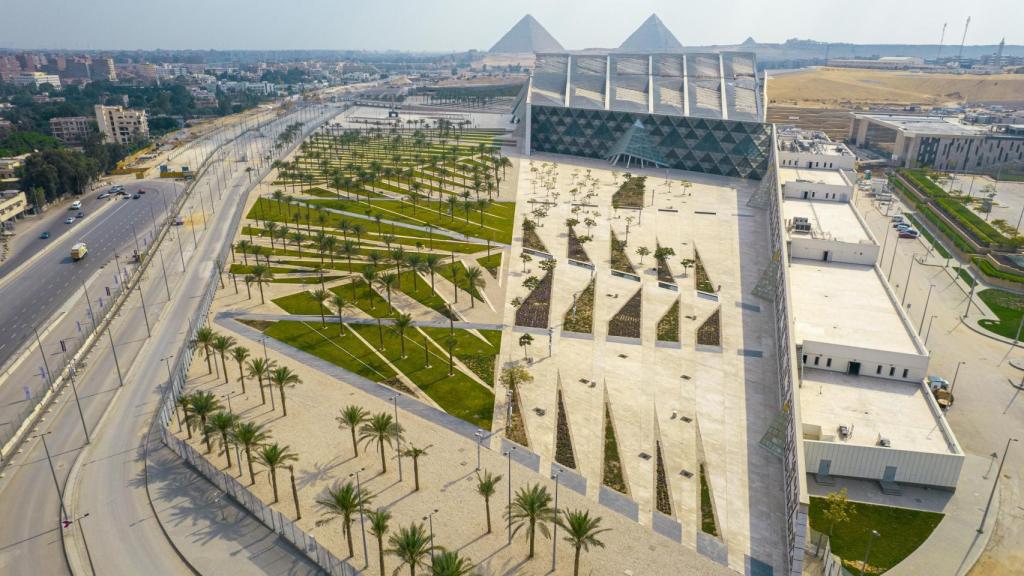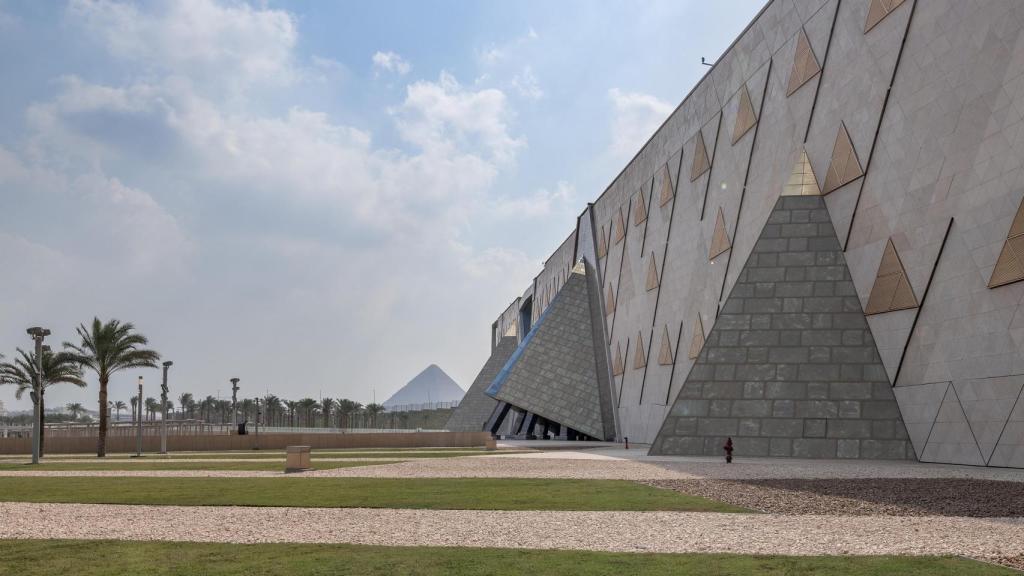It is said that man fears time and that time fears the Pyramids. What we don’t know is whether he should look askance at the Grand Egyptian Museum, the GEM, after almost a quarter of a century in works north of the Giza plateau. To paraphrase Mark Twain, who, not in vain, climbed to the top of Cheops and endured the insistent guides who still roam the place, the rumors about its opening have certainly been exaggerated.
Since 2003 when Róisín Heneghan and Shin-Fu Peng’s Dublin-based studio was awarded by competition among 1,557 participants, the region’s political and social crises, such as the Arab Spring, have gone hand in hand with global ones, the pandemic, to incubate this endless billion dollar oeuvre.
And although it seemed ready for last July 3, The military tension between Iran and Israel once again postponed its launch to November 1. Given what we have seen – articles from five years ago already promised “no more delays” –, we are going to be prudent and avoid, whenever possible, the use of the word pharaonic.
Until that long-awaited moment, the GEM will not present the Tutankhamun exhibition nor the Cheops solar boats, located in a separate pavilion, although since October 2024 the rooms of the main collection have been able to be visited. It’s enough to get an idea.
Presumably you have read the hyperbole: 80,000 m² of galleries, 50,000 objects, 400 meters long, all for the largest museum in the world dedicated to a single civilization and that leaves the old pink building of Tahrir in its infancy. The GEM has done its homework very well, and it can even be said that Heneghan Peng’s proposal – who beat, among others, the Spanish finalists Fernando Pardo and Bernardo García Tapia – is recognizable after all the tribulations. For the good and the bad, there is everything.
The GEM has done its homework well and Heneghan Peng’s proposal is recognizable after all the tribulations
The architecture of the museum is configured with a grand gesture, a kind of elongated trapezoid that opens towards the Giza plateau. Divided into longitudinal bands, it is crossed horizontally by a 25-meter-high lobby, an airport stopover.
With its soft natural lighting and presided over by a mammoth statue of Ramses IIeffectively directs traffic: to the north, offices, common services, shops and restaurant spaces – with prices, it must be said, unaffordable to the local public; Towards the south and upwards, the galleries.

Aerial view of the complex. Photo: Grand Egyptian Museum
To access the exhibition, you have to climb a large staircase – or a mechanical ramp or an elevating platform, to choose – filled with monumental pieces, and towards which the secondary rooms flow. At the top, there is a large window that focuses again on the Pyramids before giving way to the rooms. That interior is a 12-space cascade checkerboardorganized into four horizontal plateau periods, from the predynastic to Greco-Roman influences, and three descending naves: society, reign and religion.
In essence, whenever you go down a level, you move forward in time and observe each era from those three points of view. There are contrasts: some objects on the route, such as the miniatures of rural life in the Middle Kingdom, are revealed, more than as simple curiosities, as a recognizable and even tender past, with their little cows speckled with colors; If what you prefer are the classics, There are, of course, sarcophagi galore and even a huge mummified crocodile of the Kom Ombo temple in gallery 10, in the background.
If you have come this far, you will already be convinced of the exceptional nature of the experience, but the doubts about the project are not in its content, nor are in the pragmatic container, somewhat simple and certainly anodynebut in the inability of the operation to permeate on a human scale and attend to the local context.
The material presentation of the museum borders, when it does not cross, the borders of the kitsch. The pyramidal marquee at its entrance, in gold and with an ineffable frame of hieroglyphs, is enough to realize that we have fallen headlong into cultural clichés.
Divided into longitudinal bands, it is crossed horizontally by a 25-meter-high lobby, an airport stopover.
In its technological and ecumenical pretensions, the work also suffers from weaknesses, while ignoring the artisanal strengths of indigenous construction: At the bow of the building, a crude vertical truss serves as a crutch to the overhang and erases any trace of audacitywhile in the rooms, the ceiling is constellated with luminaires and sensors scattered randomly, or an attempt is made to emphasize the oblique geometry of the floor plan by resorting to joints between materials that rarely or never coincide.
It wouldn’t be fair to single out the operator; It is the idea and its tectonics that make no sense whatsoever..

One of the museum’s facades. Photo: Grand Egyptian Museum
In broader terms, the operation also admits criticism. Whatever the result, it would hardly justify such an expense, not to mention that its debatable involvement in the territory clearly demonstrates how quickly the future expires. It is undeniable that the GEM It is an offspring of the Bilbao effect, that is, an emblematic work that aspires to promote its location.
But just like so many cities have discovered since then, Neither the difficulties of Cairo nor the economy of Giza are going to be solved by magic and thanks to a museumno matter how spectacular it is. Quite the contrary, both this project and the ostentatious urban developments that are advertised on the highways – New Cairo, the City of October 6 – suggest a growing social gap.
Egypt dreams of a diffuse and glittering Western prosperity that is gradually edging out what it already has. “It’s not for the people,” say the locals if you ask them about that immediate future.
The museum is now a large mass with no more connection to its surroundings than the asphalta lack that will last a long time given the works, of course infinite, on line 4 of the metro. What good is the new without progress?
Hanging obelisk. Photo: Grand Egyptian Museum
A glance at the old Tahrir building, with its wooden display cases, its stacked mummies, its handwritten signs, its half-closed shutters, or even its guards smoking at security checkpoints, suggests an ignored potential that already exists in the life that the city exudes, among the people and on the same bank of the Nile, where it always was.
Perhaps it is precisely there, in the purpose of recovering this heritage within reach, where the authentic future of the Cairo people lies, and not in reducing them once again to potential tourist guides. A bet, an alms and an opportunity are very different things.

